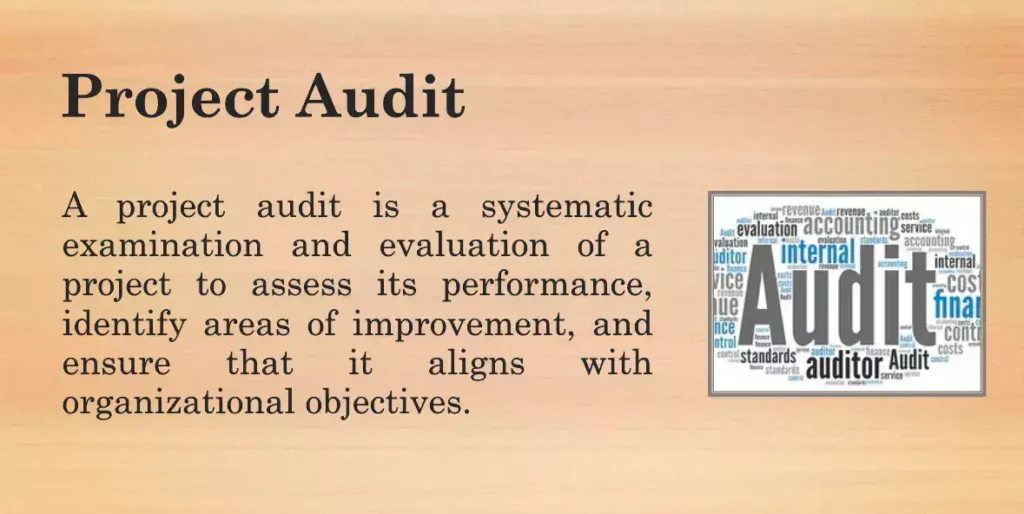Table of Contents:
-
- Meaning of Project Audit
- Objectives of Project Audit
- Levels of Project Audit
- Phases of Project Audit
Meaning of Project Audit
Project audit can be defined as the process of detailed inspection of the management of a project, its methodology, its techniques, its procedures, its documents, its properties, its budgets, its expenses and its level of completion. Project auditing can be carried over on the whole project or a part of the project.
The project audit can be used to develop success criteria for future projects based on the analysis of the audit of the present project. Further, this will help the organization to learn to avoid mistakes in future. The project audit which is conducted at the mid-term of a project or its closure will have the same steps. The project audit consists of the following:
1) Risk identification, cost, levels and severity,
2) Project work break-down structure verification and its relevance,
3) Measurement of risk impact;
4) Mitigation measures and costs;
5) Key criteria questionnaire on project compliance;
6) Progress versus objectives;
7) Work package/major task budgets and costs, and
8) Individual questionnaire at a detailed level;
Objectives of Project Audit
The common objectives of project audit are as under.
1) Provide a clear picture, from time to time, of the actual status of the project.
2) Create awareness among the project staff about the types and magnitude of problems that are likely to occur in the project.
3) Spot a variety of generic problems that are associated with the execution of projects.
4) Prompt identification of the factors that might cause product quality problems or lead to time and or cost over-run.
5) Assist in the establishment of appropriate standards and systems and recommend suitable work techniques.
6) Enable the creation of a sound information base for proper estimation and costing of the project.
7) Formalise experiences and expertise in project management to provide consultancy services to other enterprises.
8) Identify training needs concerning project tasks.
Levels of Project Audit
A project audit generally carries out the following three levels of audit:
1) General Audit
A general audit is typically a brief review of the project, conducted within a limited period and with only a few resources. It usually covers all six dimensions of the auditing report: the present status of the project, the future status, the status of important tasks, assessing the risk, information related to other projects, and the limitations of the project.
2) Detailed Audit
A detailed audit is typically conducted as a follow-up to the general audit. This detailed audit is carried out when an unacceptable level of risk has been identified during the general audit. The depth of a detailed audit depends on the seriousness of the issues and their impact on the objectives of the project, the more serious the issue, the greater the depth of the audit.
3) Technical Audit
A technical audit is conducted when a detailed audit fails to satisfactorily assess the technical aspects of a project due to the auditor’s lack of technical knowledge. In such cases, the project auditor engages a technically qualified individual to conduct the audit, following certain guidelines. When highly sophisticated and confidential technology is used, it is often difficult to find technical auditors from the organization itself. In such cases, academic consultants are often employed by the organization. To ensure confidentiality, the consultants have to sign the document of non-disclosure. Although it is not a hard and fast rule, a technical audit is generally conducted in a detailed manner.
Phases of Project Audit
The project audit has three phases as listed below:
-
- Success criteria and questionnaire development,
- Data collection and analysis, and
- Report development.
All these three phases are described as follows:
1) Determination of Success Criteria and Questionnaire Development
In this phase, we should interview the core sponsor and Project Manager to determine their success criteria for the project audit. This will help the audit team to find out whether their individual and collective needs are met. The audit team should design a questionnaire to be circulated among each member of the core project team and selected stakeholders. The questionnaire helps them to reflect on the project’s successes, failures, challenges, and missed opportunities. The guidelines for developing project audit questions are presented below:
i) The open-ended questions can be used for team members and/or other stakeholders who cannot attend an interview.
ii) Questions should be developed so that they will help to identify the major project success, the major issues, concerns and challenges, management of vendors, management of risk and change, working of the team together, handling of reporting and meetings, etc.
2) Data Collection and Analysis
The data collection and analysis involves the following tasks:
i) Conducting individual research interviews with the project sponsor, Project Manager and project team members to identify the past, current and future issues, concerns, challenges and opportunities.
ii) Conducting individual research interviews with stakeholders including vendors, suppliers, contractors, other project internal and external resource persons and selected customers.
iii) Assessing the issues, challenges and concerns in more depth to get to the root causes of the problems.
iv) Reviewing all historical and current documentation related to this project, including the following:
-
- Team structure,
- Scope statement,
- Business requirements,
- Project plan,
- Milestone report,
- Meeting minutes,
- Action items,
- Risk logs,
- Issue logs, and
- Change logs.
v) Review the project plan to determine how the vendor plan has been incorporated into the overall project plan.
vi) Interviewing selected stakeholders to identify their assumed expectations of the project and to find the extent to of their expectations were fulfilled.
vii) Reviewing the project quality management and the product quality management to identify the issues, concerns and challenges in the overall management of the project and to identify the opportunities that can be realised through improvements to the attention of project and product quality.
viii) Identifying the lessons learned that can improve the performance of other future projects within the organisation.
3) Report Development
The tasks of the report development of the project audit are listed below:
i) Compiling the information collected from all the interview.
ii) Compiling the information collected from individuals who only completed the questionnaire.
iii) Synthesising the findings from the project documentation review.
iv) Identifying the issues, concerns and challenges presented through the review of the project quality management and product quality management plans and separating the opportunities which may be realised.
v) Identifying all of the project’s issues, concerns and challenges.
vi) Identifying all the opportunities of the project that can be realised through the recommendations of the report.
vii) Identifying the lessons learned that can improve the performance of future projects within the organisation.
viii) Finalising the creation of the report and recommendation based on the findings and presenting this detailed report and recommendations including the road map to get future projects to the next level of performance.

You May Also Like:-
